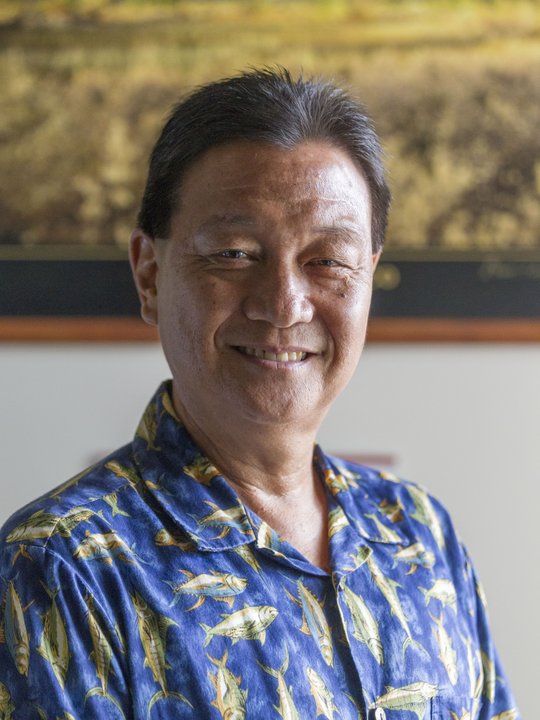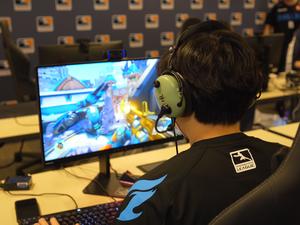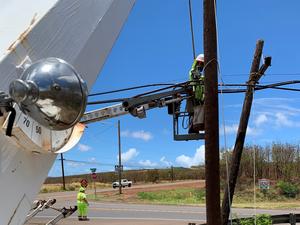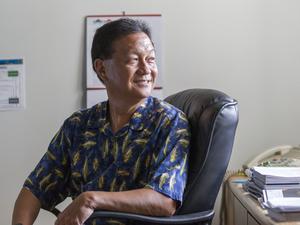One by one, the four panelists on Pacific Business News’ Technology Roundtable gave voice to their issue with an outdated premise.
They did so tactfully in the virtual session on July 30, gently but unquestionably pushing back on the notion that a segregated tech sector is a savior for a future Hawaii economy less dependent on tourism.
Rather, in the panel’s eyes, there is no tech sector; there is only tech life.
“I strongly feel … the digital infrastructure is the enabler for the digital economy, and the digital economy I think is what pervades everything, from tourism to agriculture,” said Burt Lum, broadband strategy officer with the state Department of Business, Economic Development and Tourism.
He was joined by Kelly Ueoka, president of Honolulu-based IT services company Pacxa; Jordan Silva, senior manager of service delivery at Hawaiian Telcom and CBTS; and Sky Kauweloa, head of the University of Hawaii’s esports academic task force.
Meet the panelists




Lum, a lifelong techie, has heard the discussion for years, if not decades, and it only intensified with the very visible stumble of tourism for the first year of the coronavirus pandemic.
He prefers to think of tech in terms of building a broad and sturdy foundation for other things to be laid upon — including tourism.
“Create the applications, the services, the AIs that need to be developed, but it’s going to be developed across the industries that we already have in Hawaii,” Lum said.
Ueoka was in full agreement. He’s seen cloud-based services emerge as a “tidal wave” of change for all industries, one that is only going to swell in the next three to five years.
“There’s going to come a time where every job is a tech-enabled job, so it’s really not about a tech sector, so to speak,” Ueoka said. “The need is there; it’s about growing the demand. And demand is probably going to come, because of some of the digital transformation that’s already occurring.”
As an example, he pointed out Pacxa’s three-month workforce development training program has converted — along with two others with no traditional tech background — a former massage therapist who became certified as an entry-level project management business analyst. That person was then hired by Pacxa.
Silva noted Windward Community College’s Ao Kahi cybersecurity internship program for Native Hawaiian students, on which Hawaiian Telcom collaborates.
“There needs to be opportunities from businesses like us and Pacxa and everybody, and I think we’re all trying to contribute as best we can to make sure there’s a workforce to fulfill that demand once it gets there, and keep people in Hawaii,” Silva said.
Kauweloa, who is pursuing a Ph.D. looking at the intersection of video games and society, said it’s gotten more difficult to easily classify what tech is, and what it isn’t, given its increasingly hybrid nature.
He’s more interested in seeing whether the state, acting as a sort of “island nation,” can capitalize on UH’s hosting of four in-season pro esports tournaments of the Overwatch League this summer and continue to act as a bridge between the Mainland U.S. and countries in Asia.
“In so many ways, we understand Hawaii [historically] being on the periphery of these discussions,” Kauweloa said. “But, at least with Overwatch League and many other esports organizations, they’re starting to look at island nations as being pivotal points to bringing together large continents, masses of populations to play within these parameters.”
Remote control
Over 90 minutes, the panel bonded over a shared love of gaming.
Ueoka, Silva and Kauweloa all shared related tech origin stories: A young Ueoka on the Commodore 64 system; Silva evading firewalls so he could play games in his school’s computer lab; and Kauweloa duking it out in match upon match of “Street Fighter II.”
It was a recurring theme as the panelists weaved in their personal gaming experiences — headset communication, remotely working as a team, jerry-rigging a faster internet connection — with what has become the working reality for so many people over the last 16 months.
Kauweloa noted the roots of gaming and remote work are intertwined. Long before the onset of the pandemic, remote work was often ascribed to tech jobs.
“Since the dawn of technology, we’ve always imagined and dreamed of working from home,” he said.
“[Now] you’re seeing this idea of tech companies understanding that esports and video games have become training grounds for the future of work. This is both good and bad, because of course, we understand that this is the future.”
And like in gaming, it’s important to find a balance with real life. Kauweloa offered a cautionary tale: Studies of professional gamers who have logged 10 hours a day playing and communicating in front of a screen have revealed long-lasting problems with posture, eyesight, and arthritis, he said.
According to DBEDT’s December 2020 study of the tech industry in Hawaii, tech job growth remained about static from 2009 to 2019, with only an increase of 0.2% over that span — 1.9% lower than the national growth average. DBEDT counted 28,515 tech jobs in the most recently available year out of 883,000 civilian jobs in the state.
Will that change upon the release of updated pandemic figures? Perhaps. Hawaiian Telcom has made some inroads in hiring remote help from the Mainland, Silva noted, but he cautioned that it works two ways, as local talent can be poached by Mainland-based companies to work remotely from the Islands.
“It’s a little tricky, but it’s a good challenge,” Silva said. “It puts us in direct competition with larger organizations and challenges us to be better. And I think that’s good for everybody.”
Ueoka thinks his company will employ hybrid remote work for the foreseeable future — especially after he saw the Covid case count the day of the roundtable, then a Hawaii-record 622.
“Now that the technology’s proven itself, all the efficiencies we can gain by leveraging what we really already had, it’s here to stay,” Ueoka said. “For us at Pacxa, we’re totally redoing our office space to be more flexible, looking to have more innovation and a training facility built as we go forward.”
Broad bandwidth
For Lum, the society-wide shift to distributed workforces has been a blessing far surpassing the personal convenience many enjoyed.
His job got a whole lot easier because of what it forced upon others.
The Broadband Hui of like-minded infrastructure enthusiasts from DBEDT, the Economic Development Alliance of Hawaii and Transform Hawaii Government, first assembled at the start of the pandemic in March 2020. Over the last 70 weeks, it has grown from 20 participants to over 200.
“I swear, if it wasn’t for Zoom or whatever video conferencing you’re using, I would not have been to pull together the community around broadband,” said Lum, whose personal motto is “endeavor to persevere.”
When he took the job in 2018, he thought its benefits would speak for themselves. Not so.
“At that stage, nine of 10 people thought their internet came from the air, that it floated down from the heavens and got enabled by your smartphone,” he said with a laugh.
Hawaii is dependent on transpacific, undersea fiber optic cables for its connectivity to the rest of the world — most of them owned and operated by private entities, and some of them aging.
One of Lum’s longstanding goals is the construction of a carrier-neutral undersea cable landing in Kakaako to attract new lines from big players like Google, Microsoft and Amazon, stretching thousands of miles from the continents. From there, Neighbor Island landings could be built; in a previous estimate provided to PBN, he projected a total cost of up to $50 million.
“We have a project to do the engineering and design, which would be the pre-construction work, to start looking at sites on Kauai, Maui, Oahu and the Big Island,” Lum said on the panel.
He believes some federal money will help make that happen. In an Aug. 4 update of what Hawaii would receive in the federal Infrastructure Investment and Jobs Act making its way through Congress, the state could be eligible for a minimum of $100 million to improve its broadband infrastructure.
Meanwhile, equitable access to broadband on the islands themselves remains an issue, particularly in rural areas, hence the establishment of the state’s new Broadband and Digital Equity Office on July 1.
Hawaiian Telcom enabled broadband internet service at more than 10,000 mostly rural homes and businesses in 2020, it previously announced. It was awarded about $24 million by the FCC in February to continue its initiative to expand access to some 8,000 locations in rural areas.
Connection speed remains a barrier for some, Silva said.
“In the early days of Microsoft Remote Desktop and terminal servers, you would click a key on the keyboard, and if latency was too high, you’d have half a second before it pops up in your Word document,” Silva said. “It’s amazing how much those little delays just break your workflows.”
Still, UH has been able to make use of the Japan-U.S. undersea cable to route the Overwatch League’s tournament games at the Manoa campus straight to Tokyo. The speed was just enough for game developer Blizzard Entertainment, which wasn’t able to organize competition from the Mainland directly to opposing teams in Asia.
“[Previously] we’d always imagined ourselves as sort of the backwater of global infrastructure when it came to games,” Kauweloa said.
Typically, gamers in Hawaii are used to higher latency, or lag, because of the distance to Mainland servers — a handicap that can fall in the range of 80 milliseconds, Kauweloa said. Similarly, lag has affected the embrace of cloud storage services like Amazon Web Services, Microsoft Azure and Google Cloud Platform that Pacxa helps broker to assist local small- and medium-sized businesses.
“The latency is a big issue, still,” Ueoka said. “It’s very different from playing Overwatch or League of Legends [in] how people experience the lag, but the perception is ‘we cannot move our systems [offsite] because it’s too slow.’
“There’s going to be a lot of discussion around quantifying the benefit, and understanding what is the penalty,” Ueoka said.
Cyber warefare
Some of that penalty comes in the form of what Ueoka refers to as the “Wild West.”
The light side of tech, and its ever-expanding network of interconnected devices, has been mirrored in some ways by an enveloping dark side.
“There’s so many variables tying into increasing threats and opportunities for the bad guys,” Ueoka said.
Cyber criminals have only been emboldened during the pandemic, especially with ransomware attacks, he said. In the past, a single cyber criminal or group might demand $500 for the return of a business’ sensitive information. Now, upon payment, they might only hand over some of the data and demand still more money.
“Once that happens now in this day and age, it’s too late,” Ueoka said. He shook his head thinking of the prominent malware attack that forced the shutdown of the Colonial Pipeline on the East Coast in May.
"On the upside, there is a bevy of cybersecurity platforms in the cloud that can monitor business’ systems in close to real time, he said. Cyber hygiene training for remote-working employees is just as important.
“The industry is moving toward this concept of zero trust, where you don’t trust any device, you don’t trust anything connected to the network, and you treat it the same,” Ueoka said.
Easier said than done for many people working at home with family members, including children, in the same network. Gaming devices have been used as entry points into home networks, and subsequently into business networks being used from home.
“It’s a general point that organizations and companies need to take games more seriously,” Kauweloa said. “I think there has been a paradigm shift that’s happened over the past decade – the games industry as a whole is a goliath entertainment industry that outpaces movies and music globally. That’s a shock for many people when you state that fact, but there’s still this apparent lag in taking games seriously. Consoles, mobile devices and gaming PCs themselves become these interesting targets because they come through a younger demographic.”
Some newer routers are including options for segmenting devices from each other, something that’s become increasingly important, Silva said.
Silva said one of Hawaiian Telcom’s biggest training budget allocations goes to cybersecurity for his team, which includes call center and help desk employees.
There’s the obvious, like recognizing a basic phishing attempt in an email, creating solid passwords and not using the same passwords for work as social media. But it goes much deeper, including targeted spear-phishing attacks on specific people, and vulnerabilities are always shifting.
“It’s reminding people it’s an evolution,” Silva said. “What worked five years ago doesn’t work today to protect businesses, and what works today probably won’t work in five years.”
Part of the problem locally, Silva said, is that many businesses assume their small online profile makes them invisible from attackers. Not so.
Sophisticated scripts are run by programs, not people, constantly scanning the web for weaknesses.
“And when it finds one, it attacks it. And if it is successful, it hands it off to a human to then exploit,” Silva said.
Hawaii’s tight-knit business community makes it potentially vulnerable, as attackers can leap from one trusted contact to the next.
“Every company has to step up and understand that it’s not going away. It’s here,” he said.







